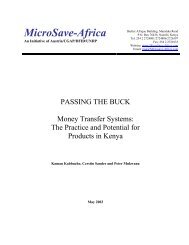You also want an ePaper? Increase the reach of your titles
YUMPU automatically turns print PDFs into web optimized ePapers that Google loves.
immense—and <strong>DAI</strong>’s projects are making a<br />
tangible difference in meeting them. In the east<br />
<strong>of</strong> the country, for example, the Alternative<br />
Development Program (ADP), led by Jonathan<br />
Greenham, improved the lives <strong>of</strong> literally millions<br />
<strong>of</strong> people between 2005 and 2009. It reached<br />
2,600 communities, bringing 24,000 hectares <strong>of</strong><br />
land into licit agricultural production; generating<br />
17,000 full-time jobs; training 118,000 farmers,<br />
government <strong>of</strong>ficials, and small business<br />
owners; and providing more than a quarter <strong>of</strong><br />
a million subsistence farmers with inputs and<br />
technical assistance that raised their incomes<br />
anywhere from 60 to 125 percent. ADP’s cashfor-work<br />
programs alone generated 6 million<br />
person-days <strong>of</strong> local employment, breathing life<br />
into local economies and leaving behind more<br />
than 200 infrastructure improvements. ADP’s<br />
successor, IDEA-NEW, also led by Greenham,<br />
is now extending ADP’s approach into northern<br />
and western Afghanistan. A Philadelphia<br />
Inquirer journalist who traveled to Afghanistan<br />
to visit the program called IDEA-NEW a “model<br />
<strong>of</strong> success.”<br />
The challenge is to continue this kind <strong>of</strong> satisfying<br />
work, to continue the <strong>DAI</strong> tradition <strong>of</strong><br />
working at the leading edge <strong>of</strong> development<br />
practice, while managing risk. At the time <strong>of</strong><br />
this writing, it appears that such risk can be<br />
managed, and <strong>DAI</strong>’s employee owners are fully<br />
committed to sustaining their efforts in Afghanistan.<br />
But the calculation <strong>of</strong> risk is a constant<br />
and conscientious one. In making its decisions,<br />
Boomgard said, the company will be guided<br />
by its touchstones: the core mission to make a<br />
difference in the world, and the core values he<br />
reiterated when he took over in 2009—people,<br />
accountability, quality, integrity, pr<strong>of</strong>itability, and<br />
independence.<br />
In many ways the decision will revisit one <strong>of</strong><br />
the abiding tensions in the <strong>DAI</strong> story: whether<br />
and how much to pursue growth. Historically,<br />
the company has always opted to grow rather<br />
than stand pat, to move from project design<br />
to project implementation, for instance, or to<br />
launch new practice areas and new <strong>of</strong>fices,<br />
or to take on ever larger and more complex<br />
initiatives for its clients. And the rationale has<br />
been constant: more projects and more diverse<br />
technical disciplines mean more opportunities<br />
for adding to <strong>DAI</strong>’s store <strong>of</strong> knowledge; and<br />
more revenues mean more resources to invest<br />
in the firm, which means a greater capacity to<br />
deliver development results. Such growth never<br />
The Alternative<br />
Development<br />
Program/Eastern<br />
Region is one <strong>of</strong><br />
USAID’s great<br />
success stories in<br />
Afghanistan.<br />
103



